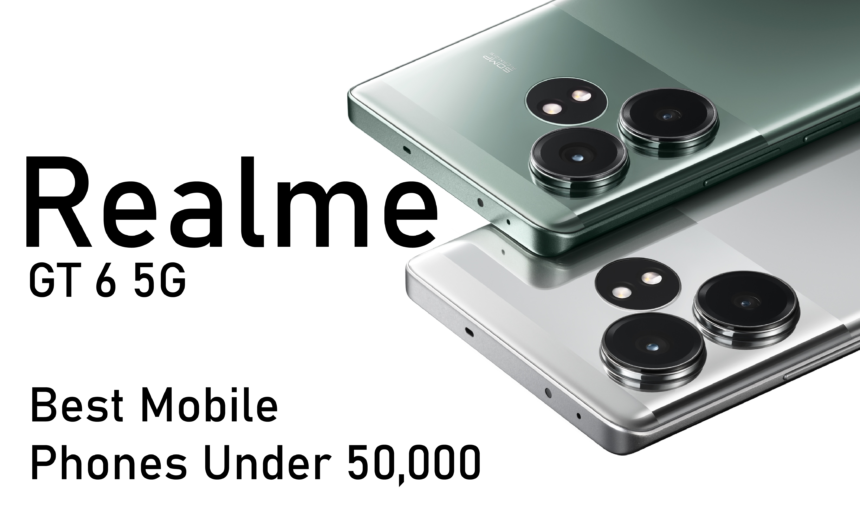Realme GT 6 5G
Eligible for taking in July 2024 Rs. Best Mobile Phones Under 50,000: Realme GT 6 5G
HIGHLIGHTS
- Realme GT 6T gets a new Miracle Purple colour option in India.
- Realme GT 6 5G is powered by the Snapdragon 8s Gen 3 and has a 5,500mAh battery
- Xiaomi 14 Civi 5G features Leica-tuned camera system
- OnePlus 12R 5G starts at the same price as the 11R 5G, Rs 39,999
- This new colour option will be available only in 8GB/256GB and 12GB/256GB models.
- The sale of the new colour will start from July 20th midnight.

Looking for a high-end smartphone without breaking the bank? Look no further! “Flagship killer” smartphones offer top-notch features at a relatively affordable price. For under Rs 50,000, you can get a device that rivals the priciest models, with fast processors, reliable camera systems, and long-lasting batteries. Here are the best phones you can buy in India this July for under Rs 50,000. The list includes Realme GT 6 5G and three more devices.
Realme GT 6 5G
We kick off the list with the top pick in our best phones list for phones under Rs 50,000, the Realme GT 6 5G. This is one of the most complete phones you can buy right now with prices starting at Rs 40,999. Powered by the Snapdragon 8s Gen 3 SoC, paired with up to 12GB LPDDR5X RAM, up to 512GB UFS 4.0 storage and a 5,500mAh battery, top-tier performance is one of the key highlights of the GT 6 5G. At the front, the beautiful curved AMOLED display with 120Hz refresh rate has up to 4,500 nits peak brightness, and watching shows or playing games is a joy on this device. As mentioned, while performance is one of the best things about the GT 6, the camera system is also surprisingly good. The Realme GT 6 5G delivers great photo and video quality in both daylight and low light.
The Last Six 5G Specifications: Advancements in Wireless Technology
The advent of 5G technology marks a transformative era in wireless communication, building on previous generations with unprecedented capabilities and potential applications. As the world witnesses the widespread rollout of 5G networks, understanding the latest specifications is essential for deciphering its impact on various sectors, from telecommunications and healthcare to automotive and entertainment. This essay will delve into the last six critical specifications of 5G technology that shape its functionality, performance, and future potential.
Realme GT 6 5G Enhanced Mobile Broadband (eMBB)
One of the cornerstones of the 5G specification is Enhanced Mobile Broadband (eMBB). This specification focuses on improving data rates and capacity to cater to an increasingly data-hungry consumer base. eMBB aims to deliver peak data rates up to 10 Gbps, which is a significant leap from 4G’s capabilities. This enables high-definition video streaming, virtual reality experiences, and advanced gaming applications without latency or buffering issues. The design of eMBB focuses on spectrum efficiency, using higher frequency bands—often referred to as millimeter-wave (mmWave)—to achieve these substantial improvements in speed and capacity. As a result, urban areas are increasingly becoming hotspots for eMBB services, with providers deploying small cells to ensure comprehensive coverage and performance.
Realme GT 6 5G Ultra-Reliable Low-Latency Communications (URLLC)
Another pivotal aspect of 5G specifications is Ultra-Reliable Low-Latency Communications (URLLC). This feature is crucial for applications that demand real-time responsiveness coupled with high reliability. URLLC targets use cases such as autonomous vehicles, remote surgery, and industrial automation, where even slight delays can lead to detrimental outcomes. With a latency as low as 1 millisecond, URLLC enables instantaneous communication between devices, which is critical in environments where timing and accuracy are paramount. Achieving this level of performance necessitates sophisticated network designs, including advanced signaling and resource allocation strategies.
Realme GT 6 5G Massive Machine-Type Communications (mMTC)
The emergence of the Internet of Things (IoT) has reshaped the landscape of communication, and Massive Machine-Type Communications (mMTC) is a defining specification of 5G tailored to accommodate this trend. mMTC focuses on enabling a vast number of connected devices to communicate effectively while maintaining minimal power consumption. The specification supports a massive scale of connections—up to one million devices per square kilometer—which is essential for smart cities, agriculture, and various industrial applications. mMTC fosters long battery life and optimal resource management, allowing devices to operate efficiently over extended periods and under varying network conditions. This connectivity not only opens opportunities for new applications but also enhances existing infrastructures, from traffic management to environmental monitoring.
Realme GT 6 5G Network Slicing
The advent of Network Slicing represents a groundbreaking advancement in 5G technology that permits the creation of multiple virtual networks within a single physical network infrastructure. Each slice can be customized to meet the specific requirements of diverse applications and services while providing the necessary quality of service (QoS). For instance, one slice can be optimized for high-speed consumer applications, while another can cater to the low-latency demands of critical industrial applications. This capability allows network operators to maximize resource utilization, enhance operational efficiency, and provide tailored experiences to different user segments, such as enterprises, public safety, and individual consumers. Network slicing is anticipated to bring about a paradigm shift in how telecommunication companies design and manage their services, driving revenue growth and innovation.
Realme GT 6 5G Direct Device-to-Device (D2D) Communication
Direct Device-to-Device (D2D) communication is another notable innovation included in the 5G specifications. This feature allows devices to communicate directly with each other rather than routing information through a centralized base station. D2D can significantly enhance communication efficiency, reduce latency, and conserve network resources. Its applications range from cooperative vehicle systems, where cars communicate to avoid collisions, to advanced social networking features that facilitate direct content sharing between smartphones. D2D communication empowers new paradigms of interaction among devices, leading to improved operation in various sectors, including gaming, disaster recovery, and social connectivity.
Realme GT 6 5G Energy Efficiency and Sustainability
In the context of global sustainability efforts, energy efficiency has been integrated as a significant specification in 5G technology. The design considerations for 5G components strive to reduce power consumption across the entire network, from the core infrastructure to end-user devices. Enhanced energy efficiency not only lowers operational costs for network operators but also aligns with global initiatives aimed at reducing carbon footprints. Techniques such as advanced network management, intelligent scheduling, and incorporating energy-efficient hardware play crucial roles in achieving sustainability goals. This specification underscores a broader trend within the telecommunications industry to evolve into a more environmentally conscious sector.
Realme GT 6 5G Conclusion
In summary, the last six specifications of 5G technology—Enhanced Mobile Broadband (eMBB), Ultra-Reliable Low-Latency Communications (URLLC), Massive Machine-Type Communications (mMTC), Network Slicing, Direct Device-to-Device (D2D) Communication, and Energy Efficiency and Sustainability—collectively highlight the exponential advancements that 5G brings to telecommunications. Each specification not only improves the existing capabilities of mobile networks but also paves the way for innovative applications that can revolutionize industries, enhance user experiences, and support global sustainability efforts. As the rollout of 5G continues, its specifications will serve as the backbone of future development, influencing the evolution of technology in diverse fields and shaping how we interact with the world around us.
TAGGED: –
- Trump assassination bid
- Realme GT 6 5G
- July 2024
- Best Mobile Phones Under 50,000
- Donald Trump’s
- ‘Either the luckiest man alive or divine hands here’
- onedaynews
- newnews
- oneplus nord 5 launch date in india specifications
- oneplus nord 5
- launch date in india specifications
- OnePlus Nord 5 Specification Launch Date in India
- OnePlus
- Nord 5 Specification Launch Date in India



